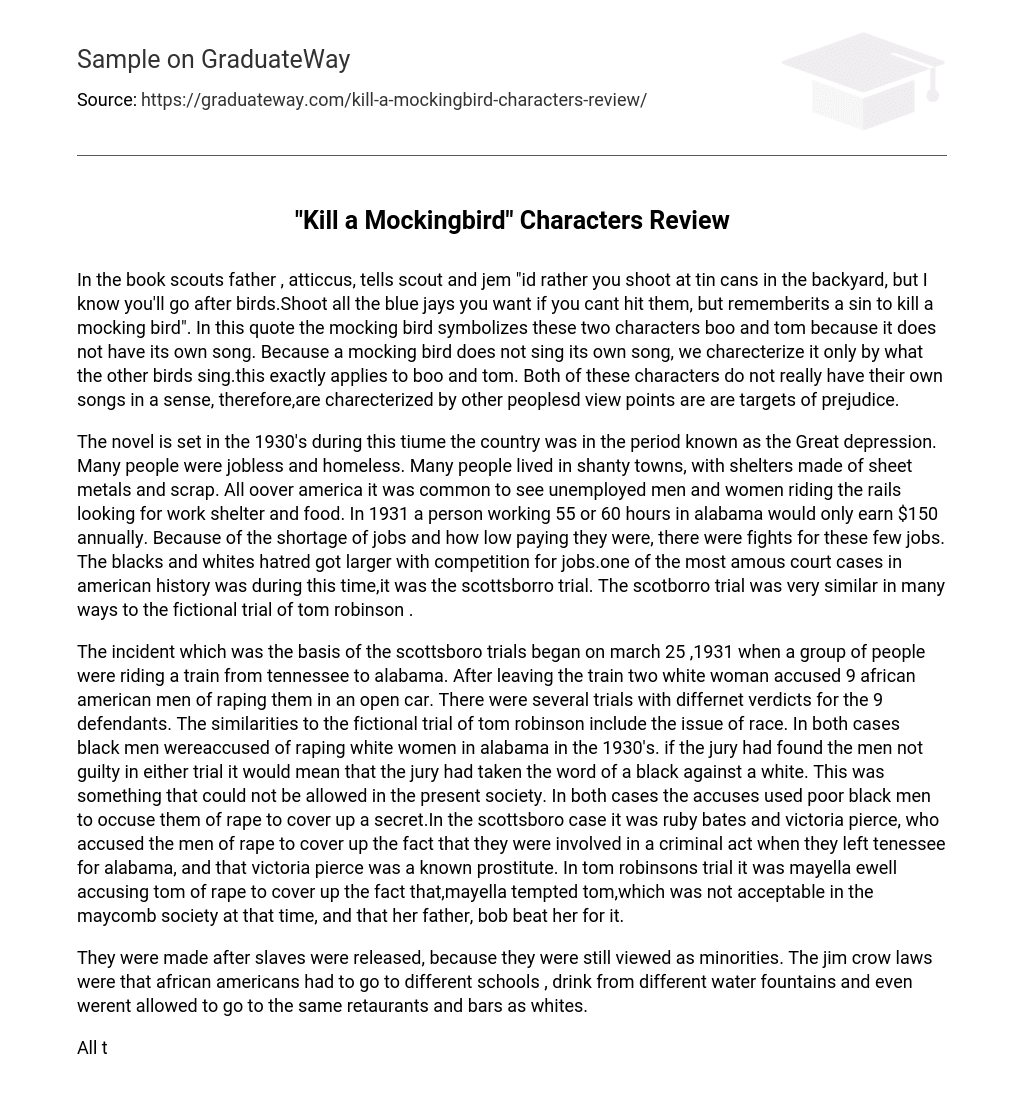In the novel “To Kill a Mockingbird,” Atticus, Scout’s father, advises her and Jem to aim at tin cans in the backyard instead of birds. However, he acknowledges that they will likely target birds, especially blue jays. He allows them to shoot as many blue jays as they desire as long as they can’t hit them. Nevertheless, he emphasizes that it is considered a sin to kill a mockingbird. This quote symbolizes Boo Radley and Tom Robinson because these two characters are like mockingbirds who lack their own “songs.” Like mockingbirds, their identities are only shaped by what others say about them. Consequently, both Boo and Tom face prejudice and judgments from others.
During the Great Depression in the 1930s, a time marked by high unemployment and homelessness, the novel is set. Shanty towns with makeshift shelters made of sheet metal and scrap were prevalent, while many jobless individuals traveled by train seeking work, shelter, and food. Back in 1931, if someone worked 55 or 60 hours in Alabama, they would only earn $150 per year. As jobs were scarce and wages low, competition for employment often led to conflicts, particularly between black and white people. The Scottsboro trial, an infamous court case in American history, occurred during this period and shared similarities with the fictional trial of Tom Robinson.
The Scottsboro trials originated from an incident on March 25, 1931. During a train journey from Tennessee to Alabama, two white women accused nine African American men of raping them on an open car after disembarking from the train. Multiple trials took place, resulting in different verdicts for the defendants. The trials shared similarities with the fictional trial of Tom Robinson, as both cases involved accusations of black men raping white women in 1930s Alabama. A not guilty verdict would have meant that the jury believed a black person’s testimony over a white person’s, which was deemed unacceptable in society at that time. In both cases, the accused individuals were poor black men who were made scapegoats for covering up other transgressions. In the Scottsboro case, Ruby Bates and Victoria Pierce accused the men of rape to conceal their involvement in a criminal act during their journey from Tennessee to Alabama. Additionally, it was revealed that Victoria Pierce was a known prostitute. In Tom Robinson’s trial, Mayella Ewell accused him of rape to hide the fact that she had made advances towards him, which was socially unacceptable in Maycomb during that period. Furthermore, her father, Bob, punished her for this behavior.
The Jim Crow laws were implemented after the emancipation of slaves, as they continued to be regarded as minorities. These laws mandated that African Americans attend segregated schools, utilize separate water fountains, and were barred from entering the same restaurants and bars frequented by white individuals.
All these worries prompted the black community to initiate a civil rights movement in order to protest their labeling as inferior citizens.
The character Boo Radley in the novel is a victim of prejudice. He faces rejection and does not fit into Maycomb society due to his differences, resulting in punishment from a judgmental community. Boo’s actions deviate from what society considers normal, appearing mysterious and abnormal. For instance, he once stabbed his father with scissors and showed no remorse or apology. As a result, Boo isolates himself from the people of Maycomb, choosing to stay inside his home where he remains unseen for fifteen years after some legal trouble. He knows that if he were to venture outside, he would be unfairly regarded as a foreign visitor due to his enigmatic behavior. It is this understanding that leads Boo to remain secluded and avoid the ridicule of his society.
Boo is the subject of gossip and is considered the town’s peculiar character. The townspeople wonder about Boo’s activities inside his house. It is believed that Boo would venture out at night, under the cover of a moonless sky, and secretly observe any minor illegal activities occurring in Maycomb. The townsfolk would point fingers at Boo and hold him responsible for every trivial offense.
Tom Robinson, a black man accused of raping a white woman, becomes the primary target of prejudice in Maycomb due to his race. The difficulties faced by African Americans in Maycomb during the 1930s were compounded by the existence of the Jim Crow laws. These laws were established after the emancipation of slaves and perpetuated the perception of African Americans as minorities. Jim Crow laws mandated segregated schools, separate water fountains, and prohibited African Americans from patronizing the same restaurants and bars as white individuals.
Tom Robinson, in the eyes of the white society, is viewed as a “sorry nigger” who committed an unfathomable crime. Within the novel, Tom serves as a representative for the black community in American society. Similar to Boo Radley, Tom Robinson’s character is shaped by the rumors and judgments of the people residing in Maycomb county. Following accusations of rape, many perceive him as a malevolent creature. During the trial, the white townspeople feel conflicted about supporting Tom over a white woman. Their opposition is evident in their rejection of Atticus as Tom’s attorney, labeling him a “nigger lover” for his unwavering commitment to defending Tom with utmost diligence.
In the 1930s, there was a belief that white people’s testimony carried more credibility than black people’s. This is shown during Mr. Gilmer’s cross-examination of Tom in court, where he questions Tom by saying, ‘you claim she is lying, boy?’ This indicates that even if Mayella is not being truthful, the white community will still believe her over any black person, whether they are honest or not.





